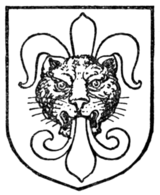however, except as a supporter or crest, is by no means common in English heraldry. It will be found, however, in the crests of some number of families; for example, Taylor and Potts.
A very similar animal is the ounce, which for heraldic purposes is in no way altered from the leopard. Parts of the latter will be found in use as in the case of the lion. As a crest the demi-leopard, the leopard's head (Fig. 329), and the leopard's head affronté (Fig. 330) are often to be met with. In both cases it should be noticed that the neck is visible, and this should be borne in mind, because this constitutes the difference between the leopard's head and the leopard's face (Fig. 331). The leopard's face is by far the most usual form in which the leopard will be found in armory, and can be traced back to quite an early period in heraldry. The leopard's face shows no neck at all, the head being removed close behind the ears. It is then represented affronté. For some unfathomable reason these charges when they occur in the arms of Shrewsbury are usually referred to locally as "loggerheads." They were perpetuated in the arms of the county in its recent grant. A curious development or use of the leopard's face occurs when it is jessant-de-lis (Fig. 332). This will be found referred to at greater length under the heading of the Fleur-de-lis.
The panther is an animal which in its relation to heraldry it is difficult to know whether to place amongst the mythical or actual animals. No instance occurs to me in which the panther figures as a charge in British heraldry, and the panther as a supporter, in the few cases in which it is met with, is certainly not the actual animal, inasmuch as it is invariably found flammant, i.e. with flames issuing from the mouth and ears. In this character it will be found as a supporter of the Duke of Beaufort,




